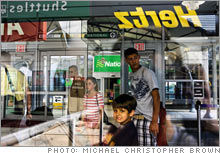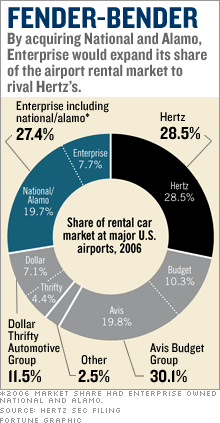Enterprise pulls up at the airportBuying two also-ran airport brands, Enterprise is making a big move into Hertz's turf, says Fortune's Carol Loomis.(Fortune Magazine) -- The U.S. rental-car business has long had two rulers. Hertz, with 2006 revenues of $8.1 billion, has dominated the airport business ever since it started serving Chicago's Midway in 1932. Enterprise, with revenues of more than $9 billion, has virtually had a lock on the off-airport business, with a 55% market share. But now Enterprise is geared up to make a big move into Hertz's turf. Pending regulatory approval, expected in the next month, Enterprise will buy two also-ran airport brands, National and Alamo, that unexpectedly came up for sale. The deal will strikingly revamp market share, as Enterprise will make an instant jump from about 8% of the airport market to more than 27% - tailgating Hertz's 28.5%. (Also in the airport mix are jointly owned Avis and Budget, with a combined 30.1% share.)   The Enterprise deal will meanwhile solidify the company's lead in total number of vehicles, giving it - rather stunningly - almost half of all U.S. rental cars. Just how it will position its trio of brands is under hard study, but Enterprise CEO Andy Taylor says that for at least 18 months all three names will be marketed. Taylor knows that this venture has its challenges. His company, for example, has an incentive-driven culture; Alamo and National are partially unionized. But Taylor likes his prospects, saying, "I haven't had a moment of buyer's remorse." His mood may reflect what he's paying. True, the price negotiated with the current owner of the brands, Cerberus Capital Management - yes, the buyer of Chrysler - hasn't been disclosed, but Fortune estimates $1.2 billion. That would be both a good profit for Cerberus and a breeze for Enterprise, especially since it will acquire large loss carry-forwards that will reduce its future taxes. A burden for Enterprise will be higher debt. Both Standard & Poor's and Moody's greeted this deal by lowering Enterprise's credit ratings, a change that will bump up the company's interest rates. But they will still be lower than Hertz's. The differentiator here is the structures of the two companies. St. Louis-based Enterprise is a private firm that since 1957 has gone from nothing to revenues that will be about $12 billion after the National/Alamo deal. Taylor wouldn't dream of taking Enterprise public and has no financial reason to do so. He actually sewed up the pending purchase by offering a no-contingencies, all-cash deal. Hertz (Charts, Fortune 500), on the other hand, is a highly leveraged company that is controlled by a group of private-equity firms. So far its lead investors - Clayton Dubilier & Rice, Carlyle Group, and Merrill Lynch Global Private Equity - have no complaints. The three bought Hertz from Ford Motor (Charts, Fortune 500) in late 2005 for $2.3 billion in equity and very quickly expanded Hertz's debt so that they could pay themselves dividends that reduced their cost basis to just over $1 billion. Then they took Hertz public and watched its stock rise from $15 a share to more than $20. In June these owners did some unloading themselves, publicly selling just over one-fifth of their holdings for $1.1 billion. Presto! They have all of their money out and still own more than half of the company. They might want to earmark some cash for legal fees. In addition to the war on the road, Hertz and Enterprise are waging a patent battle over computer systems that each uses to make car reservations. Hertz, listing risks to its business in its June prospectus, notes that Enterprise is close to getting an important technology patent that might make Hertz guilty of infringement. Hertz, though, has counterattacked by suing Enterprise about the same patent, claiming Enterprise made inaccurate and anticompetitive statements to key customers about how harmful the patent will be to Hertz. Nonsense, says Enterprise, moving that the lawsuit be dismissed. Consider this a case of corporate road rage, with a final reckoning yet to come. From the July 23, 2007 issue
|
Sponsors
|
